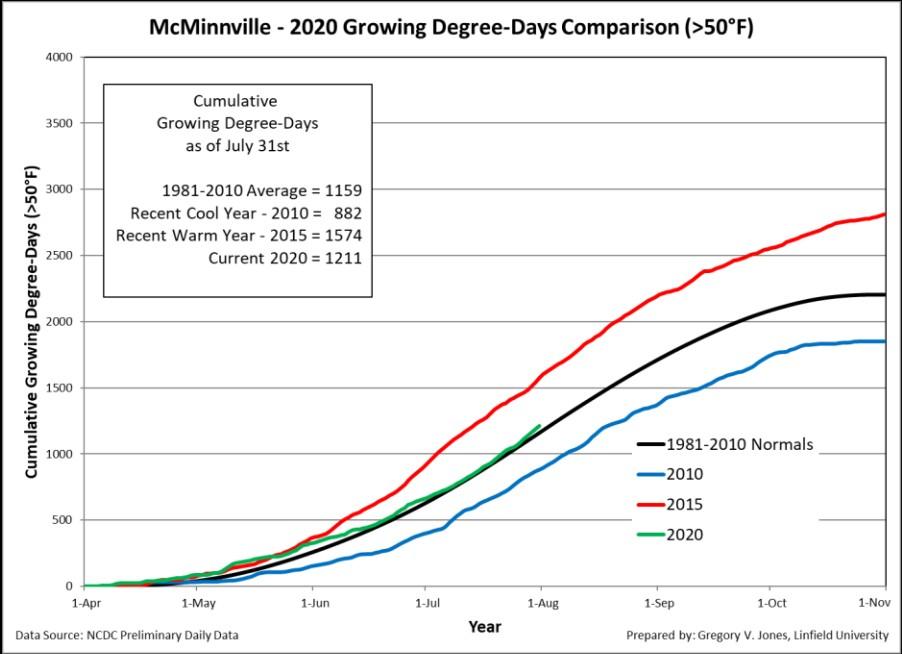
If growers and winemakers throughout the Pacific Northwest enjoyed the fruits of their labor from the 2019 vintage, then Mother Nature might be providing a somewhat similar season from an already unforgettable 2020.
A number of weather stations throughout the Northwest are showing heat unit accumulations somewhere between the 30-year average from 1981 to 2010 and those of the 2019 vintage, according to acclaimed climate researcher Gregory V. Jones, director of the Evenstad Center for Wine Education and Evenstad Chair in Wine Studies at Linfield College in McMinnville, Ore.
“Growing degree-days (GDD) from March through July for the western U.S. shows the vintage so far is largely running near normal to above normal,” Jones wrote in his Weather and Climate Summary and Forecast for August. “GDD amounts over most of California, Oregon and Washington are currently 5-10% above normal or running 4-16 days ahead of average for this time of the season.
“However, some areas are slightly behind in heat accumulation with eastern Washington, eastern Oregon and Idaho 5-10% down or about one week behind.”
Drought monitor in orange for 2020 vintage




Fortunately, there are no signs that the 2020 growing season will end up near the historically hot 2015 vintage, but it will continue the recent trend of being dry.
“The longer-term outlook for the U.S. through October continues to show the forecasted dry conditions for much of northern California, Oregon and central Washington with drought development and/or persistence through summer and into fall,” Jones wrote.
At the weather station he charts in the Walla Walla Valley town of Milton-Freewater, Ore., there were 1,665 growing degree days through July 31, which has it cooler in terms of recent vintage. Those compiled GDD nearly match the 30-year average from 1981-2010 average of 1,667, but last year, that station recorded 1,859 GDD by Aug. 1. At the same stage in the record-hot vintage of 2015, there were 2,317 cumulative GDD.
“Medford, Roseburg, and McMinnville are running above the 1981-2010 normals for the months March through July (4 to 21%), while eastern Oregon (Milton-Freewater and the Walla Walla region) is right at the long-term average,” Jones reported.
“Similarly, compared to the average of the 2004-2019 period for the sites, Medford and Roseburg are 4 and 9% up, respectively, while McMinnville is 2% below average, and Milton-Freewater is 10% down,” he continued. “Compared to 2019, Medford is 2% up, Roseburg is 1% down, McMinnville is 5% down, and Milton-Freewater is 12% below values seen in 2019.”
WSU AgWeatherNet figures similar to 2019 GDD

Washington State University’s AgWeatherNet logs growing degree days via its 177 stations across the state as well as parts of Oregon and Idaho.
Through July 31, there were 1,933 growing degree days recorded at the East Mattawa Station on the Wahluke Slope. A year ago, it charted 2,023 GDD. During the 2015 vintage, it stood at 2,345 when August began.
At the Benton City station near Red Mountain, there were 2,073 GDD recorded. A year ago, it read 2,081 GDD. In 2015, there were 2,486 GDD.
On Snipes Mountain in the Yakima Valley, there were 1,960 GDD registered. A year ago, the accumulation stood at 1,961 GDD. During the blistering 2015 season, it was 2,436.
At Phinny Hill in Klickitat County’s Horse Heaven Hills, that station measured 1,803 GDD. In 2019, it read 1,942. Back in 2015, before the temperatures really began to race in the Columbia Valley, there were 2,182 heat units.
Along the Columbia Gorge, Husum notched 1,232 GDD. A year ago, it stood at 1,296. The Pullman school’s station in Woodinville collected 1,059 GDD, compared with 1,117 GDD last year. Back in 2015, it received 1,415.
In McMinnville, the heart of Willamette Valley’s Pinot Noir territory, there were 1,211 growing degree days — not far ahead of the 30-year average of 1,159. That is considerably behind the 2015 mark of 1,574. Back in 2019, there were 1,271 GDD.
However, data from the two Southern Oregon sites used in his report are reminiscent of the 2019 vintage, particularly as result of heat accumulations slowing during July again. In Roseburg, home to the Fault Line Vineyards and Abacela Winery established by his father, Earl Jones, there were 1,748 GDD compared to 1,758 from last year. They pale by comparison to the 1,991 of 2015.
In Medford, not far from the Southern Oregon University campus where Greg Jones spent two decades as a faculty member, the station charged 1,923 GDD. Last year, there were 1,891 heat units. In 2015, they measured 2,190. The 30-year-average is 1,587.
Trend of warmer, more humid nights to continue

In recent years, the Northwest wine industry has noticed an increase in humidity and a diminished diurnal shift, the cooling off that helps Northwest grapes retain more natural acidity and balance. According to Jones, more of the same can be expected.
“Elevated humidity and higher nighttime temperatures are still in play, and given the state of the North Pacific warmth, will likely continue into the fall,” he wrote.
For the first half of August, the Columbia Valley may not see the 100-degree temperatures experienced in the end of July.
“The August forecast is currently pointing to the western U.S. likely ending up warmer than average and near average to below average in precipitation,” Jones wrote. “There is some model output suggesting a circulation change over the North Pacific which could lower the confidence for an overall warmer August, but it is too soon to tell how this flip will play out.”
There is hope that this year’s harvest will be marked by moderately dry conditions while avoiding something similar to last year’s unseasonably early “game over” hard freeze of Oct. 10 that saw the temperature plummet to 22 degrees in the Walla Walla Valley.
“The 90-day outlook for precipitation continues to indicate that the western U.S. is likely to remain near average which would indicate a dry first half of the 90-day period and seasonal thereafter,” Jones wrote.

Leave a Reply